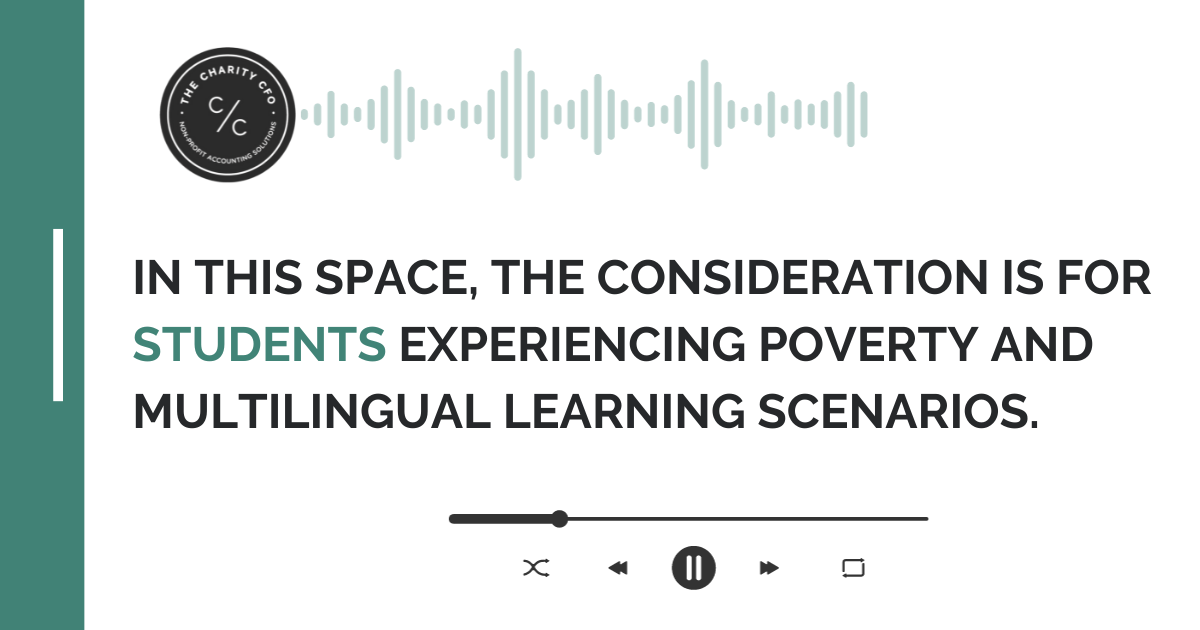On today’s episode of the Modern Nonprofit Podcast, we are joined by Sheryl Cababa, Chief Strategy Officer at Substantial.
The approach for today’s conversation will be slightly different than most interviews. Sheryl spends her time in a concept of systems and design thinking. Don’t worry we’ll discover more of what that means throughout the conversation with her today.
First, let’s understand Substantial and who they are. We learn from Sheryl that the group is a research strategy and development studio based primarily out of Seattle, WA. Their main focus is working with those in the domain of education.
More specifically, Sheryl uses her skills in design and strategy research and thinking to help increase equitable outcomes in education.
So what does all of that mean?
Substantial will work with groups like the Bill and Melinda Gates Foundation and other well known organizations to elevate students’ voices during a decision making process.
Basically, they will take the end user (student) and design backwards from there based on their unique perspectives.
Even further they work directly with students to do the following:
- Engaging with them
- Understanding their context
- Researching with them
- Involving them in the designing process
Design & Systems Thinking
We get it, there are still tons of questions left about this whole design and systems thinking. So, let’s break them down even further.
Design thinking in short is technically a methodology that provides a solution based approach to solving problems.
Let’s take a problem and observe it from a 30,000 foot view. In most cases, a problem provides the opportunity for a solution. Because of this It’s safe to say problems and solutions go together like peanut butter and jelly.
Design Thinking comes into the picture when the recipient of the problem is considered.
To keep it simple: The problem? A flat tire. The recipient? A driver.
Design thinking is a way of working directly with the driver on how to fix his/her problem. So, it would be like AAA coming to help the driver on the side of the road and asking them how they should work together to best solve the problem.
Except Sheryl and her team are more skilled in education than they are in flat tires.
Now that we understand the idea of Design Thinking, Systems Thinking takes it even a step further.
This is the idea that once you work with the person on the other side of the problem, they may not be the only person to experience that problem. So, the solution must be designed in a way that is blanked enough for everyone to utilize while still considering the uniqueness of the individual in the problem to begin with.
The more we understand about this way of thinking the deeper we understand the factors and interactions between people and objects that must be considered in the overall design of the problem.
Not only the subjects themselves, but also the subjective, qualitative aspect of the problem.
Balancing the Equation
Sheryl tells us the use of these tools are powerful because they allow for designing and testing solutions with the people who are on the other end of the problem. And along the way, the opportunity exists to analyze and understand the system.
Here are some questions that could be asked in design/systems thinking:
- Why are things the way they are?
- What are some potential barriers and challenges?
- What are some potential unintended consequences?
- How can the greatest impact be achieved?
This is especially powerful in the nonprofit sector of business. Tosha’s experience in mental health services and government contracting roles helped her see the benefit of systems and designs thinking. More specifically how this type of thinking can help organizations understand their client’s needs better by providing the appropriate resources to them and the organization.
This is the definition of putting a consumer or client first.
When the conversation moves towards funding from the federal government, this methodology holds an entirely independent weight. The problem is the funding can sometimes be received in a way that essentially predetermines the solution. As it can be seen, when a business is receiving funds where those funds predetermine the solutions, it may be beneficial for the funding source to communicate with their fundees with design and systems thinking.
The terminology ‘balance the equation’ comes from Sheryl and her team’s work with the Bill and Melinda Gates Foundation. This was a project centered around better outcomes in math education for middle and high school students with black and latino backgrounds.
In this space, the consideration is for students experiencing poverty and multilingual learning scenarios. Therefore, if the funding is not necessarily addressing these issues, then we recognize the problem.
So, how is the equation balanced? Sheryl and her team work in between the funders and recipients to bring awareness and solutions to this issue.
Sheryl puts it all together when she says,
“I think it really often lies with the funders to ensure that they are giving enough space for nonprofits to respond to the community in a way that reflects their expertise and their areas of impact. Also, having a really good funding strategy that is focused on systematic change.“
The methodology focused on by Sheryl and Tosha today is such a key piece of understanding what Sheryl does specifically within her own practice and how Substantial impacts communities across the US.
To learn more about Sheryl’s practice, visit here.
You can also find Sheryl on LinkedIn or her book Closing the Loop Systems Thinking for Designers, online where books are sold.
You can find Tosha and the Charity CFO team on Youtube or our website, thecharitycfo.com!

Do You Struggle to Make Sense of Your Financial Statements?
Get our FREE GUIDE to nonprofit financial reports, featuring illustrations, annotations, and insights to help you better understand your organization's finances.
Get the free guide!



0 Comments